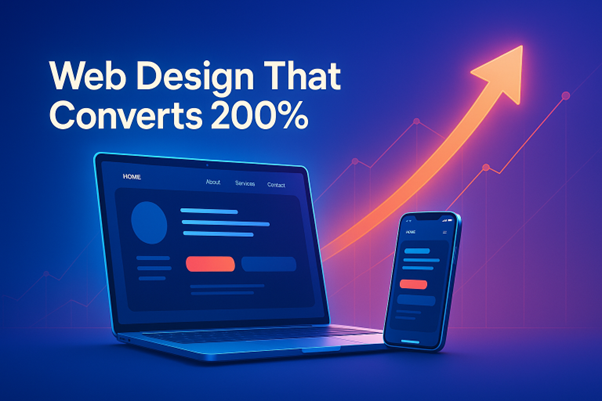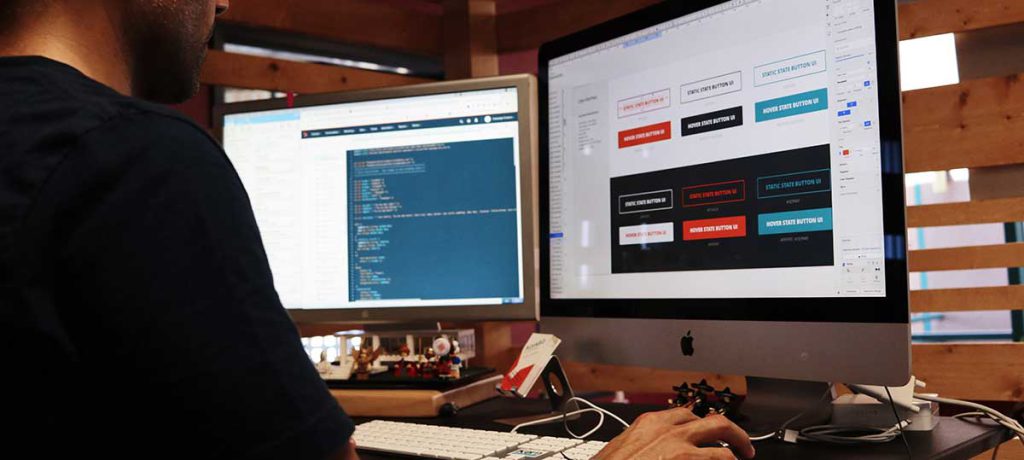Discover how strategic web design increases conversion rates. Learn proven design techniques, psychology principles, and optimization strategies that turn visitors into customers.
Web Design That Sells: How Smart Design Can Double Your Customers by 2025
Is your website doing its job?
Many businesses spend big to drive traffic. But when visitors land on the site, they bounce. Why? Bad design. It kills interest and trust in seconds. That’s money lost every single day.
Here’s the kicker: A well-designed website can boost your conversion rates by up to 200%. This isn’t hype. It’s backed by real-world data and over a decade of insights I’ve gained working with website performance. Let’s break down how you can turn your website into a powerful sales machine one smart design choice at a time.
Design isn’t just pretty pictures it’s what makes your site sell
Your website design is your digital salesperson. It works 24/7. But if it’s not built right, it’s turning customers away instead of pulling them in.
Great design goes way beyond colors and fonts. It’s about psychology, user behavior, and making every click feel easy and natural. Even small tweaks like button placement or headline tone can mean the difference between a visitor bouncing or buying.
Use psychology to guide clicks, build trust, and trigger action
People don’t shop with logic alone. They buy based on feelings—then justify it with facts.
Smart design taps into these mental shortcuts:
- The anchoring effect makes the first price you see your comparison point.
- Loss aversion nudges users to act fast, so they don’t miss out.
- Social proof reviews, testimonials, and usage stats makes people feel safer buying.
Colors also carry meaning. Red creates urgency. Blue builds trust. Green signals growth or money. Orange brings energy. But meaning shifts across cultures, so test what works best for your audience.
Layout matters too. Visitors tend to scan pages in predictable shapes like an “F” or a “Z.” Placing key actions in those paths boosts clicks. Add visual cues, like arrows or white space, to guide attention.
Want more conversions? Show you’re legit. Add trust badges, real customer photos, security icons, and direct contact details. People won’t buy if they don’t feel safe. And emotions drive first impressions. Fear of missing out, the need to belong, the desire for convenience great design touches these feelings first. Then it supports the decision with facts.
Every design element should push users closer to a purchase
Your site has one job: help people become customers. So every part of it text, buttons, images, spacing needs to support that goal.
Call-to-action buttons work best when they’re big, bold, and placed where the eye naturally lands. The words matter too. “Start My Free Trial” is better than “Submit.”
Online forms should be simple. Only ask for the info you absolutely need. Use one-column layouts. Give users helpful feedback when they make a mistake. For longer forms, add a progress bar to reduce drop-offs.
Navigation should feel effortless. Use clear labels. Don’t hide important pages. And never make people click more than they have to.
Mobile design is now non-negotiable. With over 60% of traffic coming from phones, your site must load fast, look clean, and use buttons that are easy to tap. This isn’t optional it’s survival.
Also, speed matters more than ever. A slow site loses attention (and money). Compress images, clean up extra code, and invest in solid hosting.
The first thing visitors see without scrolling your “above the fold” content should answer: “What’s in it for me?” in three seconds or less. Make it count with a headline, image, and crystal-clear value promise.
Too much on-screen? Use white space to keep things clean. It draws focus and prevents decision fatigue. Less clutter, more action.

Landing pages work best when they focus on one goal only
Landing pages should do one thing and do it well. Whether it’s collecting leads or selling a product, every section should move the visitor toward that one goal.
The top of the page called the hero section needs a punchy headline, a compelling visual, and a strong call-to-action. Visitors decide fast whether to stay or bounce, so lead with value.
Talk about benefits, not features. “Save 5 hours a week” hits harder than “Time Tracking App.” People care about outcomes, not specs.
Don’t overwhelm users. Use progressive disclosure to reveal details as needed like expandable FAQs or tabbed content. This keeps the page clean but informative.
Strategically place social proof. Add customer testimonials, review scores, or brand logos where they support your message. But don’t let them pull focus from your main CTA.
Ease people’s fears with risk-reducers. Think money-back guarantees, free trials, or simple return policies. These small promises lead to big results.
Finally, stop exits before they happen. Exit-intent popups that offer a discount or freebie can win back up to 15% of visitors. Use them wisely.
Online stores need design that builds trust and drives quick decisions
In e-commerce, your customer can’t hold the product. That means your site must do all the heavy lifting.
Product pages should highlight high-res images, clear prices, and a big “Add to Cart” button. Show shipping details early nobody likes surprises at checkout.
Make the shopping cart easy to use. Let customers update quantities, see shipping costs, and choose from multiple payment options. Guest checkout is a must.
A clean checkout flow saves sales. One-page checkouts, auto-fill fields, and mobile-friendly payment buttons make a huge difference. Every extra step loses money.
Photos are more powerful than words. Let users zoom, browse different angles, or see the item in real life. Bonus: Show pictures submitted by customers.
Use upsells and cross-sells with care. Bundle products or recommend add-ons only if they’re truly helpful.
Finally, trust seals and policy links reduce anxiety. Let buyers know their purchase is safe.
Mobile design requires special attention to tap, scroll, and speed
Designing for mobile isn’t just shrinking your desktop layout. It requires its own thinking.
Buttons must be thumb-friendly. Tap targets should be big, with plenty of space around them.
Forms need to be smart. Use the right keyboard (numbers for phone fields), fewer fields, and autofill to make it painless.
Keep navigation simple. Hamburger menus work but make sure users can find what they need fast. No one wants to pinch-zoom to explore.
Mobile CTAs should be big, bright, and thumb-reachable. Test different placements for best results.
And mobile speed? It’s even more critical. People often browse on slower networks. Optimize images, strip out unnecessary code, and load only what’s needed.
You can’t improve what you don’t measure so test everything
Don’t guess. Test.
Start with the biggest impact elements like headlines, CTAs, images, forms, and layouts. Even small changes here can move the needle.
Use heat maps to see where people click and how far they scroll. Tools like Hotjar or Crazy Egg reveal what matters to real users.
Track where people leave. Funnel analysis shows drop-off points. Fix those first.
Key metrics to watch? Conversion rate, time on page, bounce rate, and revenue per visitor. Google Analytics is your friend here.
Feedback matters too. Use surveys and interviews to understand what users feel qualitative insights often reveal what numbers miss.
And most importantly, keep testing. Regular optimization keeps your site fresh and ahead of the competition.
Different businesses need slightly different design rules
Not every site needs the same design.
- Software companies need to push free trials and highlight features with comparison charts.
- E-commerce stores should focus on product discovery, trust, and fast checkout.
- Service providers must build authority using real photos and strong testimonials.
- B2B brands should use deep content and lead nurturing tools for long sales cycles.
- Nonprofits must tell emotional stories and offer easy ways to donate.
- Local businesses should make contact info, maps, and hours super easy to find.
Final thought: One small design change could double your business
Your website design might be quietly leaking sales. The good news? Fixes don’t have to be massive.
You now have the playbook psychology tips, design tactics, mobile tweaks, testing strategies. Use them. Start small. Test one change. Then another.
This isn’t just about aesthetics. It’s about results. You don’t need to redesign your entire site tomorrow. Just take one step today.
So ready to turn your website into a true sales machine?


